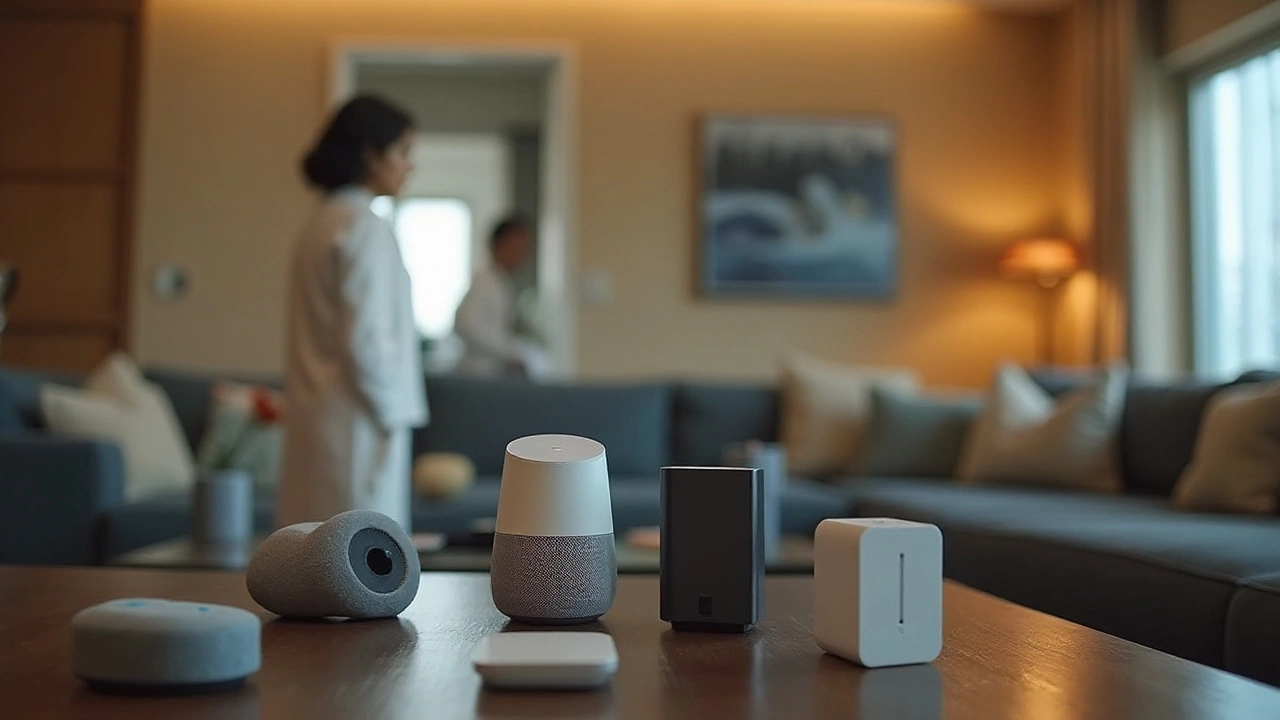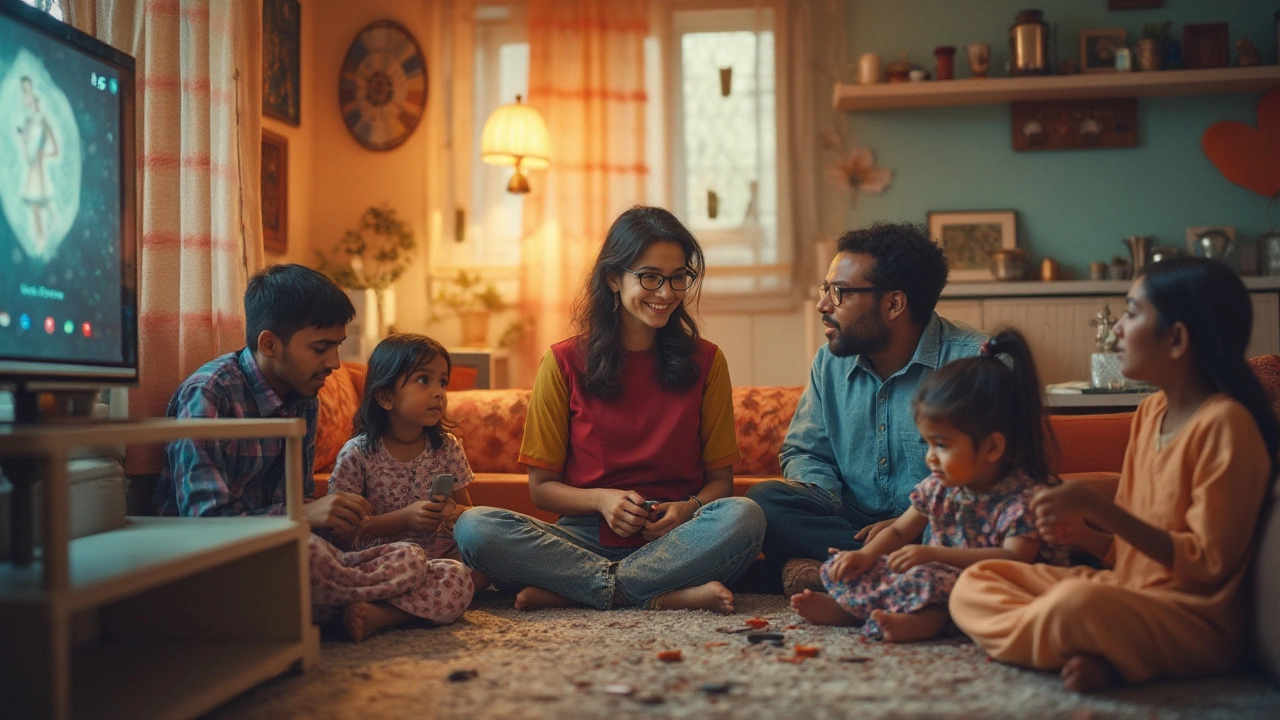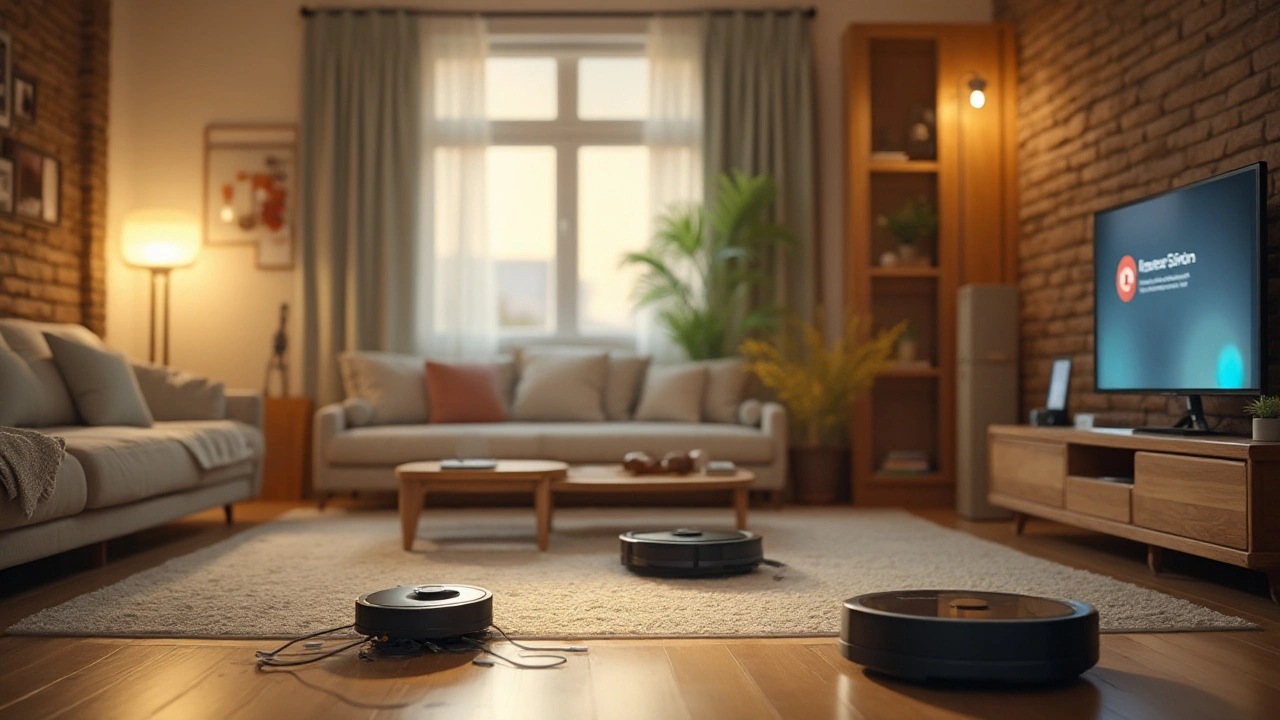
In the evolved landscape of home automation, smart devices beckon with the promise of ease and efficiency. But as glittering as this promise is, it's essential to shed light on the potential downsides of this digital trend. These disadvantages, while often overlooked, play a pivotal role in shaping our experiences with these intelligent systems.
Ironically, the very convenience touted by these devices can sometimes open doors to issues that could affect your peace of mind. It's important for potential users to delve into these aspects before fully committing to the smart home revolution. Here, I will unravel these challenges, breaking down everything from privacy pitfalls to system kinks that might just make you pause. Let's explore the digital landscape that might not always be as seamless as it seems.
- Privacy Concerns
- Security Risks
- Internet Dependency
- System Compatibility
- High Costs
- User Experience Challenges
Privacy Concerns
The allure of smart home technology comes with a hidden cost—privacy. In a quest for making our homes more efficient and convenient, we sometimes unknowingly trade personal information. This trade-off is significant, as every data point collected by your smart device is potentially a piece of you. Whether it's your daily routine captured by smart cameras or the number of hours you sleep registered by your sleep tracking device, the level of information that's being surveilled is extraordinary. These details could potentially be analyzed, scrutinized, and even exploited by service providers, raising essential questions about their responsibility and intentions.
Recently, there have been numerous cases highlighting the extent of personal data access by these devices. A study by Carnegie Mellon University discovered that smart speakers from popular brands often listen more frequently than they advertise, capturing conversations not intended for them. This has generated a wave of discomfort among users, igniting debates about consent and personal space in a world dominated by technology. User privacy becomes a headline topic every time these studies surface, showing that the general populace is concerned about losing control over their own information.
"The benefits of these technologies are undeniable, but there must be stringent rules governing how our data is used," stated an article in The Guardian, emphasizing the need for better privacy regulations in the industry.Moreover, the spectrum of security risks broadens with the inclusion of more devices into the household network. This interconnected web creates a larger target for potential cyber intrusions, threatening not only privacy but also the safety of personal assets. A breach in one device could potentially expose the entire network, leaving sensitive information vulnerable to illicit hands.
Adding to this complexity is the fact that many users are often unaware of the privacy policies associated with their smart devices. Companies sometimes embed these policies in lengthy user agreements, making it easy for important details to be overlooked. Users might unknowingly consent to sharing far more data than they intended, merely through lack of understanding or awareness. It calls for more thoughtful engagement from companies towards creating simpler and more transparent guidelines.
For those concerned about preserving their privacy while still wishing to enjoy the conveniences of a smart home, there are a few prudent steps to consider. Start by thoroughly investigating the privacy policies of your chosen devices. Look for options that allow you to opt out of data sharing practices you are uncomfortable with. Regularly update all devices to ensure they have the latest security patches. Moreover, consider structuring your home network to isolate smart devices from more sensitive personal devices, minimizing the risk of cross-contamination in case of a security breach.
Turning a house into a smart home is an exciting venture but should be approached with an understanding of privacy implications. Consumers need to weigh the benefits against the potential exposure of personal information, seeking solutions that keep them in control. After all, maintaining a balance between innovation and personal privacy is vital for embracing technology without sacrificing what makes our homes sacred and secure.
Security Risks
The allure of smart home devices often masks some of the lurking perils behind their seemingly seamless operation. At the forefront of these concerns are security risks, which form an unavoidable part of the landscape. With each connected device, a new point of entry is created for potential cyber threats. This connectivity is both a blessing and a curse, as the same technology providing convenience can also expose your home to prying eyes.
It's alarming yet true that hackers have at times manipulated systems as simple as smart thermostats to gain deeper access. Once inside the network, a malicious actor can access sensitive data or even hijack your home automation, turning it into a playground for their unethical endeavors. In 2022, a report by the cybersecurity firm Symantec highlighted that as many as 1.5 billion cyberattacks were launched on IoT devices over a single half-year period.
Among the many types of security risks, "man-in-the-middle" attacks are particularly insidious. Here, the attacker secretly relays and potentially alters the communication between two parties who believe they are directly communicating with each other. This can mean false commands being sent to devices or sensitive data like passwords being intercepted. With smart home technology relying heavily on communication between devices, the threat of such breaches is real.
Data Privacy Concerns
The constant data flow between devices raises data privacy issues. Often, information like usage patterns, personal preferences, and even audio or video footage from smart cameras can be stored on cloud services. These services, managed by third parties, may be vulnerable to data breaches. In a staggering statistic, it was reported that an overwhelming 65% of companies using IoT devices had experienced high-profile cybersecurity incidents."The promise of connectivity is also a promise of inherent vulnerability," said Bruce Schneier, a leading voice in security technology.Users often overlook these aspects, entranced instead by the magic of automation. Yet, acknowledging these vulnerabilities is crucial for anyone entering the world of smart homes.
Mitigating Security Threats
Thankfully, there are ways to bolster the defenses of a smart home system. Starting with the basics: setting strong, unique passwords for devices and networks can make a huge difference. Utilizing two-factor authentication wherever possible adds an additional layer of security. Regularly updating all connected devices ensures that the latest security patches protect them.Moreover, a dedicated IoT network can isolate smart devices from the main network, adding a layer of security filtration. Investing in a reliable home security system with virtual private networks (VPNs) is another proactive measure. This step encrypts data between devices, making it harder for unauthorized parties to access or abuse information. Understanding these security risks and taking preventative measures allows you to enjoy the wonders of smart home technology with a little less anxiety.

Internet Dependency
The evolution of smart home technology brings a new era of innovation, yet it is heavily interwoven with our global network of information—the internet. This reliance on technology is not just a fleeting fancy but rather a significant aspect that needs to be addressed. A smart home, with its interconnected devices, is only as effective as its internet connection. When your internet service experiences an outage, your ability to control your lights, thermostat, security cameras, and more may be disrupted. Imagine sitting in your living room, unable to switch off your alarm because of a connectivity issue. It becomes evident how dependent we can become on this technology.
Internet dependency extends its tendrils into the performance and security of smart devices. These devices consistently require software updates to fix vulnerabilities, upgrade features, and maintain a seamless user experience. Without a stable connection, updates might stall, leaving your devices susceptible to cyber threats. Consider a report that revealed smart homes could be exposed to hacking due to outdated firmware. It's a stark reminder of the security risks posed by poor connectivity, emphasizing the importance of maintaining a robust and secure network environment.
A weak network can also throttle the capabilities of smart gadgets, especially in a setup where multiple devices demand simultaneous bandwidth. This can lead to lag, interruptions, and decreased satisfaction. Streaming services connected to your smart TV could buffer endlessly, smart speakers might misinterpret commands, and your smart fridge may fail to provide timely grocery notifications. As technology advances, the stress on your network grows, urging homeowners to invest in higher-bandwidth services or more powerful routers. Yet, these solutions come with their own financial implications, complicating the smart home scenario even further.
As cybersecurity expert Bruce Schneier aptly puts it, "The Internet is a tool that can be used for good or evil. It's what people do with the technology that counts."
Amidst this reliance, a significant concern is the dependency on service providers. Not only do these companies supply the internet, but they also manage it. Outages are inconvenient, but beyond that, data privacy could be compromised at the service provider level. Users might unintentionally expose themselves to surveillance or data breaches conducted by third parties. As an internet-driven phenomenon, smart homes raise intricate questions about digital exposure that many homeowners overlook. In a digitally-advanced dwelling, understanding these nuances can safeguard your user privacy.
To build resilience against these internet-based obstacles, consider having backup internet solutions like mobile data hotspots. Further, users should regularly audit their network’s security protocols and invest in strategic technologies that seamlessly manage multiple devices. With technology evolving at a rapid pace, balancing efficiency with security—not to mention a stable internet connection—is paramount to an enjoyable and reliable smart home experience.
System Compatibility
The allure of a smart home setup is often linked to the hope for seamless integration among various devices. Yet, one of the significant hurdles that homeowners often encounter is system compatibility. Since different manufacturers produce smart devices, each with its proprietary protocols and software, achieving harmony among them can resemble piecing together an elaborate jigsaw puzzle. When your smart thermostat doesn't quite speak the same language as your security system, frustrations are bound to arise.
Compatibility issues are not just limited to devices from different manufacturers. Sometimes, even products within the same brand ecosystem can falter in their capacity to cooperate. Consider the situations where a firmware update in one device introduces a new feature, but another device from the same company has yet to adapt. Such discrepancies not only lead to inefficiencies but can also render some functionalities ineffective. "Maintaining interoperability across devices is a complex challenge," notes an expert from the International Association of Smart Home Innovation.
The ripple effect is apparent when you factor in advancements like voice assistants such as Amazon’s Alexa or Google Assistant. These platforms, while designed to integrate disparate technologies, require meticulous setup and potential compromises in functionality. Perhaps even more exasperating is when a new update from these voice platforms disrupts existing setups, prompting users to reconfigure their entire system. This necessitates homeowners to not only manage their devices extensively but also keep informed about compatibility changes, posing a distinct challenge for those not technically inclined.
For those diving into smart home technology, understanding these compatibility nuances is crucial. A worthwhile step is to research and prioritize devices compatible with widely accepted standards like Zigbee or Z-Wave. Such standards offer a layer of surety, ensuring that devices, regardless of brand, will communicate effectively within your home’s ecosystem. Yet, establishing a coherent system isn’t just about matching protocol standards; it requires ongoing diligence in updating devices and platforms, sometimes becoming a task in and of itself.
In some instances, to ease compatibility concerns, homeowners resort to using smart hubs. These hubs act as central points for communication, unifying various smart devices under one umbrella. Still, they are not a panacea, as even hubs face their limitations in supporting every device and protocol out there. Users often find themselves trapped in what feels like a constant game of catch-up. This requires a fair amount of patience, as manufacturers evolve and update their products regularly, sometimes at uneven paces.
Ultimately, while the mesh of a hyper-connected home is deeply attractive, it is essential for would-be smart homeowners to tread carefully. A mindful approach, valuing extensive research and possibly professional guidance, can be immensely advantageous. Embrace a strategy where your technology limitations are acknowledged, preparing you for the intricacies that a smart home entails. In a world that is continuously innovating, keeping an eye on compatibility makes the difference between a harmonious home and a technological headache.

High Costs
The financial implications of transitioning to a smart home cannot be understated. At first glance, the sleek designs and advanced functionalities of smart devices are enticing, yet these benefits often come with a significant price tag. Initial costs include purchasing gadgets, installation fees, and potentially higher internet bills due to the increased bandwidth requirements. A single smart thermostat can cost up to several hundred dollars, and when you factor in lighting systems, security cameras, and speakers, expenses quickly snowball.
Beyond the initial setup, the costs don't stop. The reliance on multiple smart systems can lead to increased power usage. Each device, though efficient on its own, collectively can lead to marked increases in electricity bills. Some devices also require regular software updates or maintenance, which might not be free. A homeowner might suddenly find themselves needing to invest in a subscription service to keep their security cameras operational or to access premium features within their smart home ecosystem.
In rare cases, smart systems require compatible hubs or processors to centralize controls, adding another layer to the expenses. Homeowners might find themselves ensnared in a complex web of costs they hadn’t initially foreseen. For those invested in sustainability, consider the environmental cost of electronic waste from these devices, as they, like any electronic, can become obsolete.
"The cost of smart home technology can sometimes be prohibitive, presenting a barrier for consumers eager to adopt but wary of the financial commitment," suggests a 2023 article from Tech Review, emphasizing the financial challenges ahead for many.
Consumer reports highlight that the average complete smart home setup can cross several thousand dollars. This has prompted many to take a piecemeal approach—installing only the most essential devices at first to manage costs. Finding a sustainable balance between cost and value is crucial. For those contemplating entering this market, meticulously budgeting and considering the longevity and compatibility of selected gadgets can help avoid unpleasant surprises later.
User Experience Challenges
At first glance, smart home devices seem to offer an elegant solution to modern living with promises of increased efficiency and convenience. However, for many users, these promises can sometimes fall flat due to various user experience challenges inherent in smart technology. Navigating these systems isn't always straightforward, especially for those not tech-savvy. The convoluted array of apps, interfaces, and device-specific instructions often create an overwhelming environment rather than an enlightened one. Users find themselves bogged down by technical jargon, struggling to seamlessly integrate devices from different manufacturers into one coherent system.
The diverse ecosystem of smart home products means that not all devices communicate smoothly with each other, leading to compatibility issues which can prove frustrating. The need for multiple apps to control different devices not only clutters smartphone screens but also stretches user patience. This fragmentation impacts the user experience significantly, diminishing the perceived value of a smart home. Often, companies do not provide detailed manuals, expecting users to figure out the tech on their own, leading to dissatisfaction and a sense of detachment from the advertised benefits.
"The complexity of smart home systems could potentially deter users from more fully embracing these technologies," suggests renowned technologist Jane Walker in her study on home automation trends.
Further complicating things is the constant need for software updates. These updates, although essential for security and functionality, can sometimes disrupt the home environment, rendering devices inoperable until updates are complete. Such disruptions not only break the flow of everyday living but can also lead to unexpected costs when expert intervention is required. Imagine an unexpected software update cutting the lights during an important dinner or locking you out of your own home; these are very real scenarios users face.
Moreover, there's the issue of dependency on wireless networks. A momentary lapse in internet connectivity can turn a 'smart' system 'dumb', leaving users without access to critical home functions, unless they have prepared with backup manual controls. This dependency not only roots them to the internet's reliability but also to constant electricity needs, raising sustainability concerns. Incorporating all these systems calls for a well-versed understanding of data management and system operations, which not all users possess.
Lastly, the personalization intended by smart devices often requires a steep learning curve before achieving the ‘set it and forget it’ convenience once imagined. Learning every device’s unique voice commands or gesture controls, combined with tailoring routines, takes time and patience—resources not often readily available for everyone. These user experience challenges emphasize the importance of holistic approaches from manufacturers to ensure that smart technology elevates living standards without introducing unwelcome complexity.